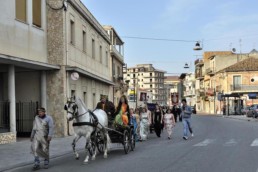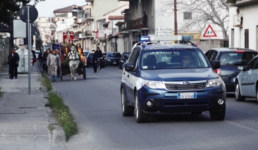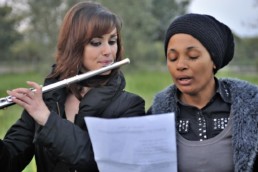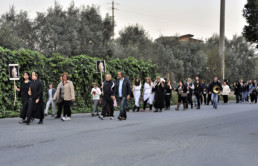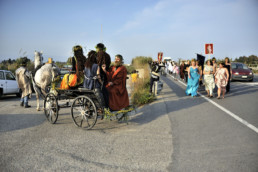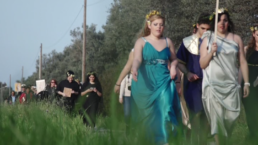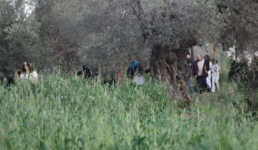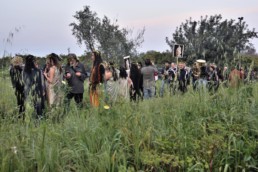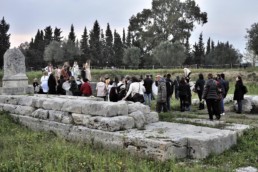Adotta la Dea di Locri – Adopt the Goddess of Locri 2013
Museo Nazionale Archeologico Locri. Nell’ambito del progetto Mitica, curated by Marò D’Agostino
Performance with citizens of Locride. Photo: LuBriglia and video: Bernardo and Nazzareno Migliaccio Spina
In addition to the mythological story of Persephone’s abduction, there is the adventurous story linked to the statue dedicated to her, dating back to the 5th century BC, which was kidnapped in the early years of the 20th century. The statue, universally considered a masterpiece of archaic art, was found in 1905 by a peasant during the replanting of a vineyard in the archaeological area of Locri Epizefiri and immediately disappeared again. After numerous and incredible passages and changes of hands, the Goddess in Throne reappears, after the First World War, at the Altes Museum in Berlin, the pride and prestige of the German capital. It is the period in which many works of art, coming from the archaeological sites of the Magna Greece, are stolen and sold illegally. The interest around Persephone is very high, the complex events related to its disappearance generate confusion and tensions: the city of Taranto in fact claims its origin. One can understand this, given the breathtaking beauty of the goddess enthroned. Corrado Alvaro wrote “this is one of those monuments that makes you forget time and place”.
Adopt the Goddess of Locri, on the day of the spring solstice, renewing the iconography of Magna Graecia, pays tribute to the divinity Persephone in a performance festival that crosses the places dedicated to her to celebrate the return to earth from the underworld, as always accompanied by the awakening of nature. Numerous associations, artists and citizens of Locride took part in the performance, who wanted to contribute actively with their presence.
“A ritual perhaps practiced at the time, or that has never existed. A sort of procession in a land where processions are dedicated exclusively to saints, often with negative intentions, then why not for once to appeal to the goddess?” says Umbaca. Starting from the Piazza del Tribunale in Locri, a shared path winds through the city, along the highway 106 and then, following what remains of the old route of the Dromo, we arrive at the temple of Marasà, in the archaeological park of the Museum . Before the performance / event, in the preliminary phase of the project, the artist set up several educational workshops in primary schools and high schools, about the relationship between the Locride territory and Magna Grecia, the myth and the current reality.
_
Alla vicenda mitologica che narra il ratto di Persefone si aggiunge l’avventurosa vicenda legata alla statua a lei dedicata, risalente al V secolo a.C., rapita a sua volta nei primi anni del ‘900. La statua, considerata universalmente un capolavoro dell’arte arcaica, viene ritrovata nel 1905 da un contadino durante lo scasso di una vigna nella zona archeologica di Locri Epizefiri e subito fatta scomparire di nuovo. Dopo numerosi e rocamboleschi spostamenti e passaggi di mano, la Dea in Trono riappare, dopo la Prima Guerra Mondiale, all’ Altes Museum di Berlino, vanto e prestigio della capitale tedesca. E’ il periodo in cui molte opere d’arte, provenienti dai siti archeologici della magna Grecia, vengono trafugate e vendute illecitamente. L’interesse attorno a Persefone è altissimo, le vicende complesse legate alla sua sparizione generano confusione e tensioni: la città di Taranto infatti ne rivendica la provenienza. E si può capire, visto la bellezza della Dea in trono, che lascia tutti col fiato sospeso. Scriveva Corrado Alvaro, è uno di quei monumenti che ti fa dimenticare il luogo e l’ora.
Adotta la Dea di Locri, nel giorno del solstizio di primavera, rinnovando l’iconografia della Magna Grecia, omaggia la divinità Persefone in una festa-performance che attraversa i luoghi a lei dedicati per celebrare il ritorno sulla terra dagli inferi, come sempre accompagnato dal risveglio della natura. Alla performance hanno preso parte numerose associazioni, la Banda di Caulonia, artisti, cittadini della Locride, che hanno voluto contribuire attivamente con la loro presenza.
Un rito forse praticato ai tempi, oppure che non è mai esistito. Una sorta di processione in una terra dove le processioni sono dedicate esclusivamente ai Santi, spesso con propositi negativi, allora perché per una volta non appellarsi alla dea? dice Umbaca. Con partenza dalla Piazza del Tribunale di Locri, si snoda un percorso condiviso che attraversa la città, lungo la strada statale 106 e poi, seguendo quello che rimane dell’antico tracciato del Dromo, si arriva al tempio di Marasà, nel parco archeologico del Museo. Nella fase preliminare del progetto, l’artista ha dato vita a diversi laboratori didattici nelle scuole elementari e nei licei, sulla relazione tra la terra della Locride e la Magna Grecia, il mito e la realtà attuale.
